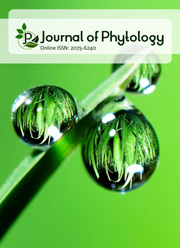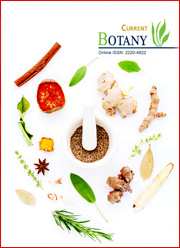Influence and distribution of lead nitrate on growth and secondary metabolite accumulation in Withania somnifera (L.) Dunal in vitro shoots
DOI:
https://doi.org/10.25081/jp.2023.v15.8756Keywords:
In vitro shoots, Lead nitrate, W. somnifera, Secondary metabolites, Field emission scanning electron microscopyAbstract
Withania somnifera is a medicinal ayurvedic plant native to India. Lead (Pb) is a toxic heavy metal which has no biological function in plants. The aim of the present study is to investigate the influence of heavy metal Pb on W. somnifera at cellular level under controlled conditions. The role of Pb on shoots of W. somnifera was determined in terms of biomass, secondary metabolite production (High Performance Thin Layer Chromatography) and phytochemical quantification. Influence and accumulation of Pb at the cellular level were recognized using UV visible spectroscopy, field emission scanning electron microscope and x-ray diffraction analysis. The current result showed that the concentration up to 2.4 mM Pb for 7 days of exposure showed higher biomass and withaferin A yield compared to control shoots. On the other hand, other secondary metabolites such as flavonoids, phytosterols and phenols levels were reduced compared to control shoots. In the morphological study, Pb concentration in the analysed sample was determined as 2%. The probability of the nanoparticle nature of the bioaccumulated lead also verified using spectroscopy and x-ray diffraction analysis. To date, we are the first to report on the influence of Pb on in vitro shoot cultures of W. somnifera.
Downloads
References
Alfaraas, A. M. J., Khairiah, J., Ismail, B. S., & Noraini, T. (2016). Effects of heavy metal exposure on the morphological and microscopical characteristics of the paddy plant. Journal of Environmental Biology, 37(5), 955-963.
Balafrej, H., Bogusz, D., Triqui, Z.-E. A., Guedira, A., Bendaou, N., Smouni, A., & Fahr, M. (2020). Zinc Hyperaccumulation in Plants: A Review. Plants, 9(5), 562. https://doi.org/10.3390/plants9050562
Castaňares, E., & Lojka, B. (2020). Potential hyperaccumulator plants for sustainable environment in tropical habitats. IOP Conference Series: Earth and Environmental Science, 528, 012045. https://doi.org/10.1088/1755-1315/528/1/012045
Chandra, S., Khan, S., Avula, B., Lata, H., Yang, M. H., ElSohly, M. A., & Khan, I. A. (2014). Assessment of Total Phenolic and Flavonoid Content, Antioxidant Properties, and Yield of Aeroponically and Conventionally Grown Leafy Vegetables and Fruit Crops: A Comparative Study. Evidence-Based Complementary and Alternative Medicine, 2014, 253875. https://doi.org/10.1155/2014/253875
Clemensen, A., Villalba, J. J., Lee, S., Provenza, F., Duke, S., & Reeve, J. (2022). How do tanniferous forages influence soil processes in forage cropping systems? Crop, Forage & Turfgrass Management, 8(1), e20166. https://doi.org/10.1002/cft2.20166
Collin, S., Baskar, A., Geevarghese, D. M., Ali, M. N. V. S., Bahubali, P., Choudhary, R., Lvov, V., Tovar, G. I., Senatov, F., Koppala, S., & Swamiappan, S. (2022). Bioaccumulation of lead (Pb) and its effects in plants: A review. Journal of Hazardous Materials Letters, 3, 100064. https://doi.org/10.1016/j.hazl.2022.100064
Delma, M. T., & Rajan, M. J. (2016). Green Synthesis of Copper and Lead Nanoparticles using ZingiberOfficinale stemextract. International Journal of Scientific and Research Publications, 6(11), 134-137.
Diba, H., Cohan, R. A., Salimian, M., Mirjani, R., Soleimani, M., & Khodabakhsh, F. (2021). Isolation and characterization of halophilic bacteria with the ability of heavy metal bioremediation and nanoparticle synthesis from Khara salt lake in Iran. Archives of Microbiology, 203, 3893-3903. https://doi.org/10.1007/s00203-021-02380-w
Elango, G., & Roopan, S. M. (2015). Green synthesis, spectroscopic investigation and photocatalytic activity of lead nanoparticles. Spectrochimica Acta Part A: Molecular and Biomolecular Spectroscopy, 139, 367-373. https://doi.org/10.1016/j.saa.2014.12.066
Hakeem, K. R. (2015). Crop Production and Global Environmental Issues. (1st ed.). Cham, Switzerland: Springer International Publishing. https://doi.org/10.1007/978-3-319-23162-4
Hu, Z., Xie, Y., Jin, G., Fu, J., & Li, H. (2015). Growth responses of two tall fescue cultivars to Pb stress and their metal accumulation characteristics. Ecotoxicology, 24, 563-572. https://doi.org/10.1007/s10646-014-1404-6
Ibrahim, M. H., Kong, Y. C., & Zain, N. A. M. (2017). Effect of Cadmium and Copper Exposure on Growth, Secondary Metabolites and Antioxidant Activity in the Medicinal Plant Sambung Nyawa (Gynura procumbens (Lour.) Merr). Molecules, 22(10), 1623. https://doi.org/10.3390/molecules22101623
Jan, S., & Parray, J. A. (2016). Heavy Metal Stress Signalling in Plants. In Approaches to Heavy Metal Tolerance in Plants (pp. 33-55) Singapore: Springer. https://doi.org/10.1007/978-981-10-1693-6_3
Khan, M. A., Ahmad, I., & Rahman, I. U. (2007). Effect of Environmental Pollution on Heavy Metals Content of Withania Somnifera. Journal of the Chinese Chemical Society, 54(2), 339-343. https://doi.org/10.1002/jccs.200700049
Kumar, D., Jamwal, A., Madaan, R., & Kumar, S. (2014). Estimation of Total Phenols and Flavonoids in Selected Indian Traditional Plants. Journal of Pharmaceutical Technology, Research and Management, 2(1), 77-86. https://doi.org/10.15415/jptrm.2014.21006
Maharia, R. S., Dutta, R. K., Acharya, R., & Reddy, A. V. R. (2010). Heavy metal bioaccumulation in selected medicinal plants collected from Khetri copper mines and comparison with those collected from fertile soil in Haridwar, India. Journal of Environmental Science and Health, 45(2), 174-181. https://doi.org/10.1080/03601230903472249
Mansoori, A., Singh, N., Dubey, S. K., Thakur, T. K., Alkan, N., Das, S. N., & Kumar, A. (2020). Phytochemical Characterization and Assessment of Crude Extracts From Lantana camara L. for Antioxidant and Antimicrobial Activity. Frontiers in Agronomy, 2, 582268. https://doi.org/10.3389/fagro.2020.582268
Mathew, B. B., & Krishnamurthy, N. B. (2018). Evaluation of lead oxide nanoparticles synthesized by chemical and biological methods. Journal of Nanomedicine Research, 7(3), 195-198.
Mathur, J., & Chauhan, P. (2020). Mechanism of Toxic Metal Uptake and Transport in Plants. In K. Mishra, P. K. Tandon & S. Srivastava (Eds.), Sustainable Solutions for Elemental Deficiency and Excess in Crop Plants (pp. 335-349). Singapore: Springer. https://doi.org/10.1007/978-981-15-8636-1_13
Miri, A., Sarani, M., Hashemzadeh, A., Mardani, Z., & Darroudi, M. (2018). Biosynthesis and cytotoxic activity of lead oxide nanoparticles. Green Chemistry Letters and Reviews, 11(4), 567-572. https://doi.org/10.1080/17518253.2018.1547926
Natarajan, K., Purushotham, P. M., Rajendran, A., Suresh, S., & Senthil, K. (2022). Comparative adaptogenic properties of Withania somnifera and Panax ginseng. Current Botany, 13, 12-18. https://doi.org/10.25081/cb.2022.v13.7599
Parameswari, M., Laras, A. E., Joni, K., Valizadeh, M., & Senthil, K. (2017). A Study on The Influence of Plant Growth Regulator on Shoot Multiplication And Evaluation of Major Withanolides in Withania somnifera. World Journal of Pharmacy and Pharmaceutical Sciences, 2017, 842-853. https://doi.org/10.20959/wjpps20178-8944
Peng, J.-S., & Gong, J.-M. (2014). Vacuolar sequestration capacity and long-distance metal transport in plants. Frontiers in Plant Science, 5, 19. https://doi.org/10.3389/fpls.2014.00019
Rout, J. R., Kerry, R. G., Panigrahi, D., Sahoo, S. L., Pradhan, C., Ram, S. S., Chakraborty, A., & Sudarshan, M. (2019). Biochemical, molecular, and elemental profiling of Withania somnifera L. with response to zinc stress. Environmental Science and Pollution Research, 26, 4116-4129. https://doi.org/10.1007/s11356-018-3926-6
Sahayaraj, K., Rajesh, S., & Rathi, J. M. (2012). Silver nanoparticles biosynthesis using marine alga Padina pavonica (Linn.) and its microbicidal activity. Digest Journal of Nanomaterials and Biostructures, 7(4), 1557-1567.
Saini, N., & Gupta, S. (2017). Assessment of Biochemical Parameters in Heavy Metal-stressed Crop of Mung Bean [Vigna radiata (L.) R. Wilczek]. American Journal of Biochemistry and Molecular Biology, 8(1), 1-9. https://doi.org/10.3923/ajbmb.2018.1.9
Sivanandhan, G., Arun, M., Mayavan, S., Rajesh, M., Mariashibu, T. S., Manickavasagam, M., Selvaraj, N., & Ganapathi, A. (2012). Chitosan enhances withanolides production in adventitious root cultures of Withania somnifera (L.) Dunal. Industrial Crops and Products, 37(1), 124-129. https://doi.org/10.1016/j.indcrop.2011.11.022
Vinod, S., Natarajan, K., Santhanu, K., Selvakumar, D., Natesan, S., & Senthil, K. (2022). Effect of seaweed elicitation and culture conditions on biomass and metabolite production in in vitro shoots of Withania somnifera. South African Journal of Botany, 151, 781-790. https://doi.org/10.1016/j.sajb.2022.10.051
Waoo, A. A., Khare, S., & Ganguly, S. (2014). Toxic effect of different lead concentrations on in vitro culture of Datura inoxia. Journal of Scientific and Innovative Research, 3(5), 532-535. https://doi.org/10.31254/jsir.2014.3512
Yolcu, S., Alavilli, H., Ganesh, P., Asif, M., Kumar, M., & Song, K. (2021). An Insight into the Abiotic Stress Responses of Cultivated Beets (Beta vulgaris L.). Plants, 11(1), 12. https://doi.org/10.3390/plants11010012
Published
How to Cite
Issue
Section
Copyright (c) 2024 Kanimozhi Natarajan, Kousalya Rangasamy, Krishnapriya Santhanu, Sangeetha Vinod, Kalaiselvi Senthil

This work is licensed under a Creative Commons Attribution 4.0 International License.





 .
.